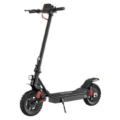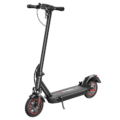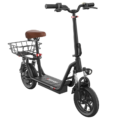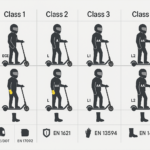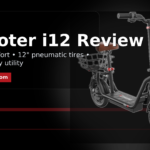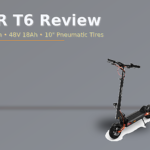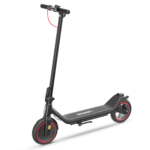- Home
- Scooters
- Electric Scooters
- iScooter iX7 Pro
iScooter iX7 Pro
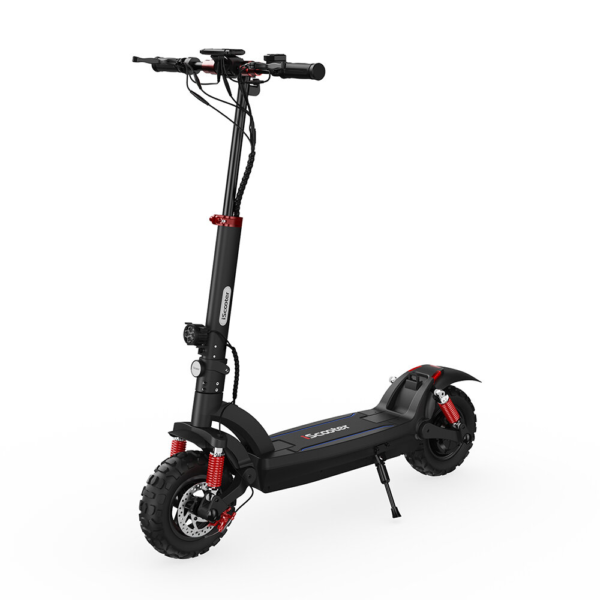

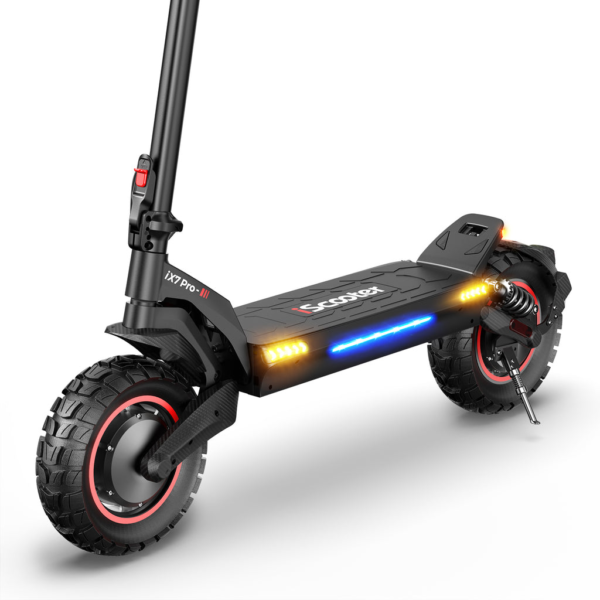

- Battery Range: 50 miles (80 km)
- Top Speed: 38 mph (61 km/h)
- Motor Power: 2 × 1200 W (dual-motor)
- Weight Capacity: 330 lb (150 kg)
- Charging Time: ~8–10 h
- Scooter Weight: 65.5 lb (30.0 kg)
PROS
- Dual-motor drive with 2×1200 W peak
- 10″ off-road tubeless tires
- Double disc brakes + EABS
- IPX4 rating with full lighting incl. turn signals
- MiniRobot app with lock/monitoring
CONS
- Heavy to carry (65.5 lb)
- Long charge time (8–10 h)
- Mechanical discs (not hydraulic)

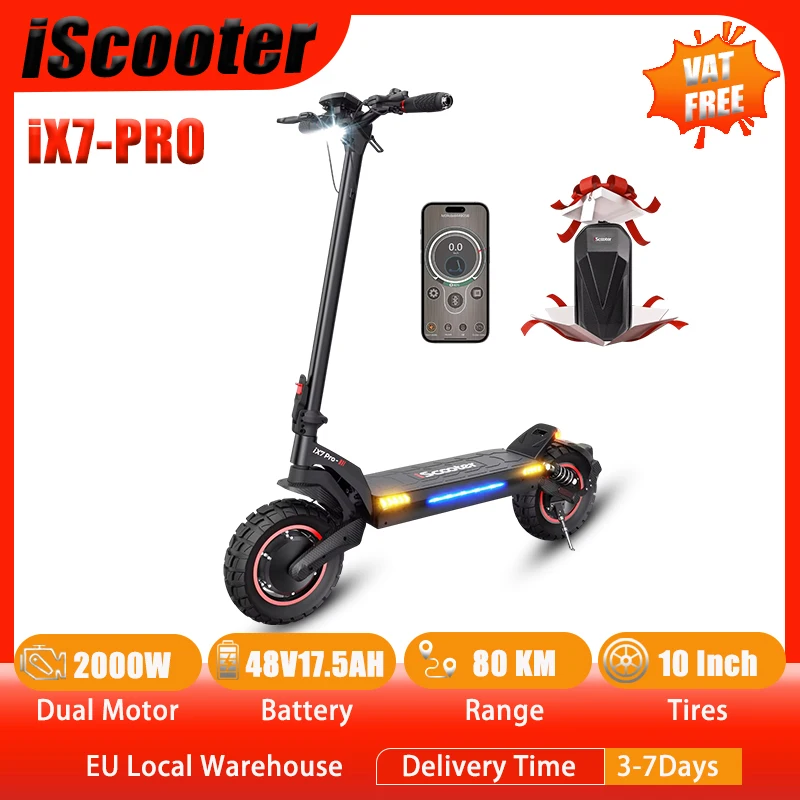

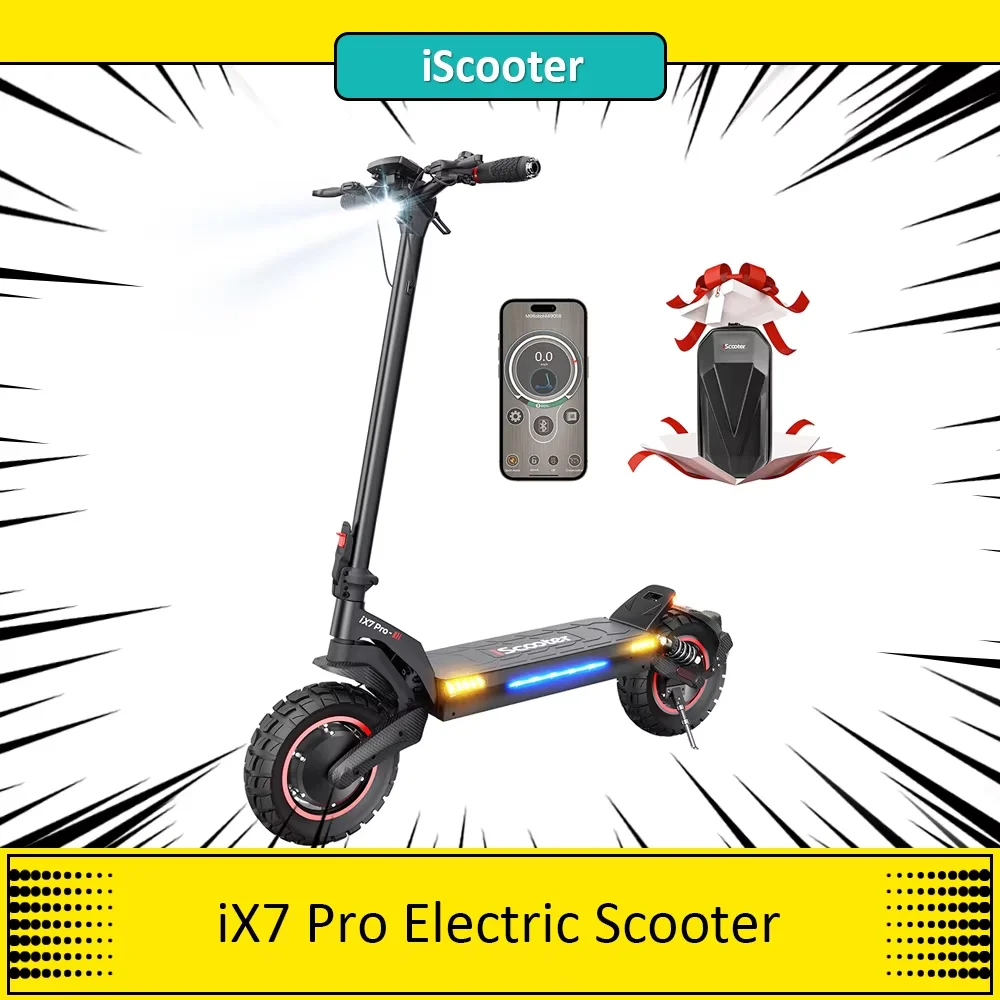


Table of contents
- What Is the iScooter iX7 Pro?
- How the iScooter iX7 Pro Works
- Key Specifications
- Design & Build Quality
- Performance Fundamentals
- Battery, Range & Efficiency
- Ride Quality & Comfort
- Braking & Safety Features
- Portability & Daily Usability
- Maintenance & Care
- Weather & Seasonal Considerations
- iScooter iX7 Pro vs Alternatives
- Who the iScooter iX7 Pro Is (and Isn’t) For
- FAQs
- Glossary
- Final Notes on Official Data
If you want an adult scooter that feels planted at speed yet remains practical for daily use, the iScooter iX7 Pro sits in that sweet spot. It blends dual-motor punch with a robust frame and a straightforward control layout, suiting riders who want confident acceleration, solid hill-climb ability, and useful range. For a same-brand reference point, see the iScooter i10 Pro review.
Because the iScooter iX7 Pro is built as an off-road-capable commuter, it handles mixed surfaces and mild trails while staying friendly for street riding where local rules allow. It does this through thoughtful engineering, not gimmicks, which is why it has become a popular upgrade over entry-level models.
What Is the iScooter iX7 Pro?
The iX7 Pro is a dual-motor electric scooter designed for adults. It emphasizes balanced performance, comfort, and stability rather than pure top speed alone. Although it can move quickly on open paths, it’s equally happy cruising at moderate pace. You get a wide deck, a sturdy stem, and a cockpit that presents the essentials clearly: speed, battery level, ride mode, and drive configuration.
Importantly, it’s not a featherweight last-mile toy. It’s a substantial machine aimed at commuters and recreational riders who value confidence over minimal mass. Therefore, it favors planted handling, long-legged cruising, and dependable braking.
How the iScooter iX7 Pro Works
Electric scooters follow a simple chain: battery → controller → motors → wheels → rider control.
- Motors & controller. Two hub motors (one in each wheel) convert electrical energy into rotation. The controller meters that energy many times per second, so power delivery stays smooth. Because the iX7 Pro lets you select rear-wheel drive (1WD) or dual-wheel drive (2WD), you can choose efficiency or maximum traction. Think of the controller as the scooter’s “brain,” blending throttle input, speed limits, and thermal protections.
- Battery. A lithium-ion pack stores energy, similar to a compact e-bike battery. Voltage (V) sets the electrical “pressure,” while amp-hours (Ah) indicate capacity. Higher Wh (watt-hours) means more stored energy and, ultimately, longer range at a given pace and rider weight.
- Throttle. A thumb lever sends a signal to the controller. Because it’s electronic, response can be tuned for gentler starts in ECO mode or stronger surge in SPORT mode. Holding a steady speed can also engage cruise control when enabled.
- Brakes. Mechanical disc brakes provide the main stopping force. Electronic braking (regen) helps slow the scooter while recovering a little energy. It feels like engine braking in a car, easing the load on the discs during longer descents.
- Safety systems. Lights, turn signals, and an easy-to-read display keep you aware and visible. The scooter’s stem latch also locks the chassis in place when unfolded, maintaining alignment during hard braking or rough patches.
In short, your inputs flow through the control system while the chassis translates that power into forward motion. The result is direct and predictable, especially in 1WD for daily trips and 2WD for steeper hills or loose ground.
Key Specifications
Below are the official, manufacturer-listed details formatted for quick reference. Values are shown in US units first, with metric in parentheses.
| Category | Specification |
|---|---|
| General | |
| Model | iScooter iX7 Pro |
| Intended use | Adult off-road-capable commuter |
| Max load | 330 lb (150 kg) |
| Recommended rider age | 14+ |
| App | MiniRobot (locking, settings, readouts) |
| Performance & Power | |
| Top speed (dual-motor) | Up to 38 mph (≈61 km/h) |
| Top speed (rear-wheel only) | Up to 31 mph (≈50 km/h) |
| Motors | Dual hub motors, 1000 W × 2 |
| Drive modes | ECO, RACE, SPORT |
| Drive configuration | 1WD (rear) or 2WD (dual) |
| Hill climb | ~25% grade (≈14°) |
| Battery, Charging & Electrical | |
| Battery | 48 V, 15 Ah lithium-ion (~720 Wh) |
| Charger | 54.6 V, 2 A; input 100–240 V, 50/60 Hz |
| Charge time | ~8–10 hours |
| Operating temp | 28–95 °F (−2–35 °C) |
| Storage temp | −4–104 °F (−20–40 °C) |
| Build & Dimensions | |
| Tires | 10 in off-road tubeless pneumatic |
| Suspension | Dual front + dual rear |
| Unfolded size (L×W×H) | 46 × 24.4 × 51 in (1168 × 620 × 1295 mm) |
| Folded size (L×W×H) | 46 × 24.4 × 22 in (1168 × 620 × 559 mm) |
| Net weight | ~65.5 lb (29.7 kg) |
| Safety & Control | |
| Brakes | Front + rear disc brakes with electronic (regen) assist |
| Lights & visibility | Headlight, tail/brake light, turn signals, under-deck lighting, bell |
| Water resistance | IPX4 |
| Features & Extras | |
| Display readouts | Speed, battery, trip/odo, mode, 1WD/2WD, indicators |
| Cruise control | Yes (toggle in settings) |
| Kickstand | Included |
| Warranty & Compliance | |
| Warranty | 12-month limited manufacturer warranty (region-dependent) |
Notes: Manufacturer speed and range ratings assume controlled conditions and a light rider at modest speeds. Real-world results vary with weight, terrain, temperature, and riding style.
Design & Build Quality
The iX7 Pro’s frame aims for strength and stability first. The deck is long and reasonably wide, which helps foot placement and stance changes on rough ground. Because the stem is stout and the latch engages with a positive “click,” alignment stays true under load. During quick stops, the chassis resists flex and maintains geometry, which improves confidence.
Up front, the cockpit layout keeps essential controls close. The thumb throttle sits where you expect it, and the brake levers offer a comfortable reach. Meanwhile, the integrated display is readable in daylight. You can see speed, battery state, drive mode, and whether you’re in rear-drive or dual-drive. Turn signals are easy to verify on the screen and in the housings, which is helpful in traffic.
Underneath, the dual-front and dual-rear suspension units damp jolts from cracked pavement and gravel. They’re tuned on the firm side for stability, not plushness. As a result, the scooter feels composed at pace, with the tires doing a lot of the smoothing once you hit the right pressure for your weight.
Fit-and-finish is practical. Panel gaps are tidy, cable routing is sensible, and hardware access for basic maintenance is straightforward. You can reach common fasteners for periodic checks without dismantling half the scooter.
Performance Fundamentals
Acceleration feel. In ECO, throttle response is gentle and predictable. RACE livens the first half of the lever, so starts feel brisk without being jumpy. SPORT plus 2WD brings the strongest surge. Even then, the power comes in steadily, which helps traction on dusty shoulders and brick pavers.
Cruising stability. The iX7 Pro prefers a planted, quiet cruise around mid-range speeds. The long wheelbase and sturdy stem reduce twitchiness. Because the off-road tires have real carcass volume, they track well across seams and worn asphalt. At higher speeds, staying loose in your knees and keeping weight centered over the deck keeps the chassis calm.
Hill-climb behavior. On 7–10% grades (≈4–6°), rear-drive manages fine with momentum. However, if a hill starts from a dead stop or the surface is loose, switching to 2WD helps the scooter step off cleanly. You’ll still need to lean a bit forward on steep ramps to keep the front planted, which is normal for dual-motor scooters.
Battery, Range & Efficiency
The pack’s 48 V, 15 Ah capacity works out to ~720 Wh, which is a meaningful step above entry-level commuters. Because energy use rises dramatically with speed and wind, range changes a lot between ECO and SPORT.
- Rated vs real-world. The manufacturer’s rating reflects gentle cruising under favorable conditions. In everyday use, a 190 lb (86 kg) rider on rolling terrain at a brisk pace should plan around half to two-thirds of the rated figure. Therefore, long, fast rides demand planning, while mixed-pace commutes can be done comfortably.
- Rider weight & terrain. Heavier loads, hills, and frequent stops cost energy. Conversely, smooth paths and steady speeds pay you back. Try to keep your pace consistent and avoid repeated hard launches if you’re stretching range.
- Temperature. Lithium-ion batteries are happiest near room temperature. Cold reduces available power and capacity; hot days increase thermal stress. Because the iX7 Pro lists operating temperatures from 28–95 °F (−2–35 °C), staying within that envelope protects the pack during daily rides.
- Charging best practices. Give the scooter time to cool before charging after a hard ride. Seat the charger connector fully, close the port cap afterward, and aim for standard, overnight cycles rather than frequent deep discharges. Finally, for storage beyond a week, park the battery around half charge in a cool, dry place.
Ride Quality & Comfort
Tires. The 10-inch tubeless pneumatic tires are the unsung heroes of this scooter. They roll over common obstacles without harshness, and they grip predictably on mixed surfaces. Because pressure matters, check it weekly. Too soft invites rim strikes and vague steering. Too firm transmits chatter and reduces traction on rough ground.
Suspension. The dual-front and dual-rear units filter bigger bumps and bridge expansion joints well. They are tuned for control more than plush “floating.” That’s a smart compromise for a scooter that can carry speed, because it prevents wallowing and keeps steering precise.
Ergonomics. The deck allows a staggered stance, which reduces fatigue and helps with weight shifts. Lever reach suits average hands, and the throttle placement avoids wrist strain during long runs. Meanwhile, the stem is tall enough for riders around average height to stand relaxed; very tall riders can rotate the bars slightly for extra reach.
Stem flex. Under heavy braking, you’ll feel a hint of flex, but it’s restrained. The latch and tube diameter do their part to keep chatter in check on rough sections.
Braking & Safety Features
The iX7 Pro uses front and rear disc brakes assisted by electronic braking. Lever feel is firm after a short take-up, and bite ramps in smoothly. Because regen helps shed speed before the discs do the heavy work, heat buildup is reasonable on long descents.
Lighting is comprehensive. You get a bright headlight for visibility, a tail/brake light for deceleration cues, and turn signals to signal intent. Under-deck lighting improves side visibility in twilight. Add the bell for pedestrian areas, and you’ve covered the basics.
For weather, the IPX4 rating means the scooter resists splashes from any direction. It’s fine for damp roads and light rain, but it’s not built for standing water or storms. Accordingly, avoid deep puddles and keep the charging port sealed when not in use.
Finally, the display surfaces the critical warnings clearly—overheat alerts, cruise control status, and drive selection—so you always know the scooter’s state before committing to a quick pass or a hill.
Portability & Daily Usability
This is a substantial scooter at roughly 65.5 lb (29.7 kg). You can carry it up a short flight of stairs, but you will feel the weight. The fold takes a few seconds: flip the safety, release the latch, and bring the stem down until the ring and clip mate. The folded package is compact in height (22 in / 559 mm), which helps it fit into car trunks with the rear seats down. However, it’s still long, so measure your space.
For security, treat it like a bicycle. Use a quality lock through the frame and a fixed object. Because the wheels are motors, you can’t remove them easily as a theft deterrent, so choose a visible, solid locking point and avoid leaving it outdoors overnight. At home, store it dry and off wet floors to protect the bearings and hardware.
Daily niceties include the kickstand’s stable footprint and the display’s imperial/metric toggle. Moreover, cruise control reduces wrist fatigue on steady commutes, and the 1WD/2WD toggle lets you tailor energy use to your route.
Maintenance & Care
A light, regular routine keeps the iX7 Pro running smoothly:
- Before rides (weekly). Check tire pressure; inspect tires for cuts. Squeeze the levers to confirm firm brake feel. Look over the stem latch for full engagement. Wipe the deck, and make sure the charging port cap is sealed.
- After wet rides. Dry the scooter with a towel. Avoid storing it soaked. Spin the wheels briefly to sling off water, then park in a ventilated spot.
- Every 150–200 miles (240–320 km). Inspect the brake pads and rotor condition. Tighten stem clamp hardware to spec. Check axle nuts and motor cables for chafe. Verify that the display and all lights work.
- App & firmware. Periodically open the companion app to check for updates and to confirm settings (units, cruise control, zero-start). Updates can improve reliability and clarity of readouts.
- Battery care. Keep the pack between 20% and 80% for daily use when convenient. Don’t store fully empty. If shelving the scooter for weeks, leave it around half charge and top up monthly.
Because the scooter uses sealed bearings and tubeless tires, puncture risk is modest if you keep pressures in range. Still, consider carrying a compact inflator and plug kit on longer rides.
Weather & Seasonal Considerations
Rain. With IPX4 water resistance, the iX7 Pro tolerates drizzle and splash. However, wet braking distances lengthen. Therefore, plan stops earlier and ride smoother. Avoid puddles that hide potholes, and keep the deck dry for traction.
Cold. Below about 40 °F (4 °C), expect reduced power and range. Rubber stiffens, so grip falls off, too. Lower your tire pressure slightly within safe limits for more bite, and warm the pack indoors before charging.
Heat. Above 90 °F (32 °C), heat-soak can nudge the system into protection sooner. Park in the shade. If the display flags a high-temperature warning, ease off and let the scooter cool before charging.
Wind. Headwinds matter. They sap range more than light hills. Tuck your elbows, stay relaxed, and use 1WD on flats to conserve energy when conditions are steady.
iScooter iX7 Pro vs Alternatives
Against commuter-class singles. The iX7 Pro accelerates harder, holds speed with less strain, and climbs better. It also rides more smoothly over bad pavement. However, it weighs more and takes more space.
Against performance bruisers. It’s lighter, simpler, and easier to live with day to day. You still get meaningful speed and hill punch, yet you avoid the bulk and complex suspension of extreme models. On the other hand, ultimate top-end and massive battery capacity belong to that higher class.
Against off-road specialists. The iX7 Pro balances trail fun with commute duty. It’s not a rock-crawler, but its tires, suspension, and dual-drive make gravel paths and park connectors enjoyable. Truly aggressive off-road scooters will have heavier frames and longer-travel suspension, which improve rough-ground pace but hurt portability.
In practice, the iX7 Pro excels as a “do-most-things-well” machine for riders who want one scooter to cover multiple roles.
Who the iScooter iX7 Pro Is (and Isn’t) For
Great for:
- Daily commuters who want a calm, stable ride at moderate to brisk speeds.
- Students and campus riders who appreciate range and dual-drive traction for varied paths.
- Multi-modal travelers who load a scooter into a car, then ride the last few miles on mixed surfaces.
- Bigger riders who benefit from the higher load rating and sturdier chassis.
Not ideal for:
- Walk-up apartment dwellers who must carry a scooter up several flights daily.
- Ultra-light last-mile users who need a quick-fold, sub-35-lb package.
- Extreme off-roaders who want long-travel suspension and very high ground clearance.
FAQs
1) How fast can the iX7 Pro go in each mode?
ECO keeps speeds modest for efficiency. RACE adds stronger pull with a higher cap. SPORT unlocks the top limit, especially when you enable 2WD. As always, ride within local rules and conditions.
2) What’s the real-world range?
It depends on rider weight, pace, terrain, temperature, and stops. Many riders will see roughly half to two-thirds of the rating at brisk urban speeds. Smoother riding extends it.
3) Does it have cruise control?
Yes. Once enabled in settings, maintaining a steady speed for several seconds engages cruise control. A brake tap or throttle input exits it.
4) Can I ride in the rain?
Light rain and wet roads are fine thanks to the IPX4 rating. Nevertheless, avoid standing water, and dry the scooter after the ride.
5) Does it support both imperial and metric units?
Yes. You can switch the display between mph/mi and km/h/km in the settings.
6) How does the dual-motor setup help on hills?
2WD shares the work between both wheels. Starts on slope feel cleaner, and traction improves on dusty or loose sections.
7) Where can I find an “iScooter iX7 Pro overview” in one place?
You’re reading it—this article consolidates the essentials and practical tips in a single guide.
Glossary
- Ah (amp-hours): Battery capacity. Higher Ah usually means longer riding at the same voltage.
- Wh (watt-hours): Total energy (V × Ah). A better single number for range potential.
- Controller: The electronics that meter power from the battery to the motors.
- Regen (regenerative braking): Electronic braking that slows the scooter while recovering a bit of energy.
- Stem flex: The slight bending you may feel in the steering tube under load.
- IP rating: Ingress protection; IPX4 means splash-resistant, not submersible.
- Dual-drive (2WD): Both wheels are powered. Improves traction and climbing.
- Rear-drive (1WD): Only the rear wheel is powered; boosts efficiency.
- ECO/RACE/SPORT: Ride modes that change throttle response and speed caps.
- Zero-start: Scooter accelerates from a stop without a kick.
- Non-zero start: Requires a small kick before the throttle engages.
- Tubeless tire: A tire without an inner tube; can be plugged for small punctures.
- Disc brake: Mechanical system using calipers and rotors to stop the wheels.
- Under-deck lighting: Side visibility lights mounted under the deck.
- Cut-off voltage: The charger/battery limit that stops charging for safety.
Final Notes on Official Data
The table above is based on the manufacturer’s listed details and the model’s user manual. Specs can vary slightly by region and production batch; temperature, rider weight, and terrain strongly affect range and performance. Always follow local regulations when riding.
Specifications
General
| Model The Model specifies the exact version or name of the scooter. It helps identify its unique design, features, and specifications within the manufacturer’s product line. Knowing the model makes it easier to compare options, find compatible accessories, or look up support information. | iX7 Pro |
| Brand The Brand identifies the manufacturer or company that designs and produces the scooter. A trusted brand is a sign of quality, reliability, and good customer support. Well-known brands often have higher standards for safety, performance, and after-sales service, giving you more confidence in your purchase. | iScooter |
| Release Date The Release Date indicates when the scooter model was officially launched on the market. This helps you know how current the design, technology, and features are. A newer release date often means updated components, improved performance, and the latest safety or smart features. | 17 November 2025 |
| Recommended Age Recommended Age indicates the minimum age range that the scooter is designed for, based on safety, size, and ease of use. Following the recommended age helps ensure that riders can handle the scooter’s speed, weight, and controls comfortably and safely. Always check local laws and use protective gear, especially for younger riders. | 14+ |
Performance & Power
| Motor Power (Wattage) What it means: The motor power, measured in watts (W), shows how strong the scooter’s electric motor is. Why it matters: Higher wattage usually means better acceleration, more torque, and improved performance on hills or rough terrain. For example, a 250W motor is good for flat city roads and light riders, while a 500W or 1000W motor provides more power for faster speeds or climbing steep inclines. | Dual motors: 2 × 1200 W (peak), dual-wheel drive |
| Top Speed The Top Speed indicates the maximum speed that the scooter can reach under optimal conditions. It’s usually measured on level ground with a fully charged battery and an average rider weight. A higher top speed allows you to travel longer distances faster, but always ensure you ride within legal speed limits and your personal comfort zone for safety. | 38 mph (61 km/h) |
| Battery Capacity Battery Capacity refers to the total amount of energy the scooter’s battery can store, usually measured in ampere-hours (Ah) or watt-hours (Wh). A higher battery capacity means you can ride longer distances on a single charge, reducing the need for frequent recharging. Keep in mind that actual range can vary depending on rider weight, terrain, speed, and weather conditions. | 48 V 15 Ah (720 Wh) |
| Estimated Range per Charge The Estimated Range per Charge indicates the average distance the scooter can travel on a single full battery charge. This range is calculated under optimal conditions, such as flat terrain, moderate speed, and average rider weight. Real-world range may vary depending on riding style, terrain, weather, and load. A longer range means fewer recharges and greater freedom for longer trips. | Up to 50 miles (80 km) |
| Hill Climb Ability Hill Climb Ability describes the maximum incline or slope that the scooter can handle while maintaining stable performance. It’s typically expressed as a percentage or in degrees. A higher hill climb rating means the scooter can tackle steeper hills without losing too much speed or power. Actual climbing performance may vary based on rider weight, battery charge, and terrain conditions. | Up to 25% |
| Drive System The Drive System refers to how power from the motor is delivered to the wheels. Electric scooters typically use either a hub motor (directly integrated into the wheel) or a chain/belt drive system. A high-quality drive system ensures smooth acceleration, efficient power transfer, and low maintenance. The choice of drive system affects performance, noise level, and overall ride experience. | Dual hub (2WD) |
Charging & Electrical
| Charging Time Charging Time indicates how long it takes to fully recharge the scooter’s battery from empty to 100% using the standard charger provided. Faster charging means less downtime and more time on the road. Actual charging time may vary slightly depending on battery capacity, charger output, and environmental conditions. | Approx. 8–10 hours |
| Battery Type Battery Type refers to the specific technology used in the scooter’s battery, which affects performance, lifespan, weight, and charging time. Most modern electric scooters use high-quality lithium-ion (Li-ion) batteries because they offer a good balance of energy density, durability, and low maintenance. A reliable battery type ensures consistent power delivery and longer riding ranges. | Lithium-ion pack |
| Removable Battery A Removable Battery means the battery pack can be easily detached from the scooter for convenient charging and replacement. This feature allows you to charge the battery separately, swap it with a spare for extended range, or securely store it indoors in extreme weather. Removable batteries add flexibility and make it easier to keep your scooter powered up wherever you are. | Non-removable internal battery (fixed pack) |
| Regenerative Braking Regenerative Braking is an energy-saving feature that converts some of the energy normally lost during braking back into battery power. When you slow down or brake, the motor works in reverse to generate electricity, which helps extend the scooter’s range and improves overall efficiency. This system also reduces wear on traditional brake components, leading to lower maintenance over time. | Yes (EABS/energy recovery) |
| Lighting Lighting refers to the built-in front and rear lights that enhance visibility and safety when riding in low-light conditions or at night. Good lighting helps you see the road ahead and ensures that other road users can see you. Many scooters include LED headlights, taillights, and sometimes brake lights or side reflectors for added safety and compliance with local traffic regulations. | LED headlight + rear LED/brake + turn/ambient lights |
Build & Dimensions
| Scooter Weight Scooter Weight refers to the total weight of the scooter when fully assembled, including the battery. This affects how easy it is to carry, lift, and store the scooter when not in use. A lighter scooter is more portable and convenient for commuting, especially if you need to carry it upstairs or onto public transport. Keep in mind that a sturdy frame and quality components may add to the weight but also contribute to better durability and ride stability. | 65.5 lb (30.0 kg) |
| Maximum Rider Weight Maximum Rider Weight indicates the highest rider weight that the scooter is designed to safely support while maintaining optimal performance and stability. Staying within this limit helps ensure reliable acceleration, braking, and climbing ability, and it protects the frame, suspension, and motor from excessive strain. Exceeding the recommended limit may reduce performance and increase wear on components. | 330 lb (150 kg) |
| Deck Size Deck Size refers to the dimensions of the scooter’s standing platform. A wider and longer deck provides more foot space, allowing you to stand comfortably and adjust your stance while riding. A well-sized deck improves balance and stability, especially on longer rides or at higher speeds. Compact decks, on the other hand, help keep the scooter lightweight and portable. | Off-road frame; wide deck |
| Handlebar Height Handlebar Height refers to the distance from the deck to the handlebars, which affects your riding posture and comfort. An appropriate handlebar height helps you maintain good balance, reduces strain on your back and arms, and makes steering more comfortable. Some scooters have adjustable handlebars to fit riders of different heights, while others have a fixed height for a streamlined design. | Fixed |
| Folding Mechanism The Folding Mechanism describes how easily and securely the scooter can be folded for carrying and storage. A well-designed folding system lets you quickly collapse the scooter into a compact size, making it convenient to transport on public transit, store under a desk, or fit into a car trunk. Look for sturdy latches and safety locks to ensure the scooter stays firmly in place when folded or unfolded. | Easy 3-step folding |
| Dimensions Folded Dimensions indicate the size of the scooter when it’s fully folded. This measurement shows how much space the scooter will take up when stored or carried, making it easier to check if it will fit in your car trunk, under a desk, or in a closet. Compact folded dimensions are ideal for commuters who need to bring their scooter on public transport or store it in tight spaces. | Unfolded: 46 × 24.4 × 51 in; Folded: 46 × 24.4 × 22 in |
| Material Material refers to the primary construction materials used for the scooter’s frame and key components. High-quality materials like aircraft-grade aluminum, reinforced steel, or durable composites provide strength, stability, and a lighter overall weight. A sturdy material ensures the scooter can handle daily wear and tear while maintaining safety and performance. | Aluminum alloy |
Safety & Control
| Brake Type(s) Brake Type(s) describe the braking systems the scooter uses to help you slow down or stop safely. Common brake types include mechanical brakes (like drum or disc brakes), electronic brakes, and foot brakes. Many scooters combine multiple braking systems for added safety and shorter stopping distances. The type and quality of brakes affect your control, especially when riding at higher speeds or on slopes. | Front & rear mechanical disc + EABS |
| Suspension Suspension refers to the system that absorbs shocks and vibrations while riding, providing a smoother and more comfortable ride over uneven or rough surfaces. Scooters may have front suspension, rear suspension, or dual suspension for better shock absorption and stability. Good suspension helps reduce rider fatigue and improves control, especially when riding on bumpy roads or off-road paths. | Front & rear suspension |
| Tire Type Tire Type refers to the kind of tires the scooter uses, which directly affects ride comfort, traction, and maintenance. Common types include solid (airless) tires, pneumatic (air-filled) tires, or hybrid options. Pneumatic tires offer better shock absorption and a smoother ride on rough surfaces, while solid tires are puncture-proof and require less upkeep. The right tire type helps ensure safe handling and a comfortable ride in different conditions. | 10″ off-road tubeless |
| Tire Size Tire Size indicates the diameter and width of the scooter’s tires, which affect ride comfort, stability, and how well the scooter handles different terrains. Larger tires generally offer better shock absorption and a smoother ride over bumps and rough surfaces, while smaller tires keep the scooter lighter and more portable. Choosing the right tire size helps ensure a balance between agility and comfort. | 10-inch |
| Kickstand The Kickstand is a built-in stand that allows you to park your scooter upright when it’s not in use. A sturdy kickstand keeps the scooter stable and prevents it from tipping over, protecting it from scratches and damage. It also makes storing and accessing your scooter more convenient, whether you’re at home, work, or on the go. | Not specified |
| Water Resistance Rating Water Resistance Rating indicates how well the scooter is protected against water and moisture, usually shown as an IP (Ingress Protection) rating. This rating helps you understand whether the scooter can handle light rain, splashes, or wet roads without damage. While most scooters are not fully waterproof, a good water resistance rating adds peace of mind when riding in changing weather conditions. Always avoid deep puddles or submerging the scooter to protect its electrical components. | IPX4 |
Features & Extras
| Display/Console The Display (or Console) shows important real-time information about your ride, helping you monitor your scooter’s status at a glance. Typical displays show speed, battery level, distance traveled, and riding mode. Some models also include additional features like Bluetooth connectivity, app integration, or backlighting for better visibility at night. A clear and easy-to-read display enhances safety and convenience on every trip. | Full-color dashboard (speed, battery, modes, signals) |
| Ride Modes Ride Modes refer to the different speed and power settings you can choose to match your riding style or road conditions. Common modes include eco for maximum range and energy efficiency, standard for everyday balance, and sport or turbo for higher speed and stronger acceleration. Switching between ride modes allows you to customize performance, conserve battery, and ride safely in various environments. | Multiple modes incl. rear-drive and dual-drive presets |
| Smart App Connectivity Smart App Connectivity lets you pair your scooter with a dedicated mobile app via Bluetooth. Using the app, you can monitor real-time ride stats like speed, battery level, and range, adjust settings such as ride modes or cruise control, lock the scooter for added security, and sometimes receive firmware updates. This feature adds convenience and allows you to personalize your riding experience right from your smartphone. | MiniRobot app (Bluetooth): lock/unlock, stats |
| Anti-Theft System The Anti-Theft System helps protect your scooter from unauthorized use or theft. This feature can include built-in alarms, electronic motor locks, GPS tracking, or remote locking through a mobile app. A good anti-theft system provides peace of mind when parking your scooter in public spaces, adding an extra layer of security to safeguard your investment. | App lock |
| Cruise Control Cruise Control allows you to maintain a steady speed without continuously holding the throttle. This feature makes longer rides more comfortable by reducing hand fatigue and providing a smoother, more relaxed riding experience — especially on flat, open roads or bike lanes. For safety, cruise control can usually be easily activated or deactivated while riding. | Yes (cruise control) |
| Accessories Included Accessories Included lists the additional items that come with the scooter to enhance your riding experience and convenience. Common accessories may include a charger, kickstand, bell, lights, phone holder, or carrying strap. These extras add value by making your scooter safer, easier to use, and ready to ride straight out of the box. | Scooter, charger (54.6 V/2 A), bag, manual, tools |
Warranty & Compliance
| Warranty Period The Warranty Period indicates how long the manufacturer guarantees the scooter against defects in materials and workmanship under normal use. A good warranty provides peace of mind, showing the brand’s confidence in its product quality. Always check what parts are covered, such as the frame, battery, and motor, and follow the maintenance guidelines to keep your warranty valid. | 12 months (region-dependent) |
| Certifications Certifications confirm that the scooter meets specific safety, quality, and environmental standards set by recognized organizations or regulatory bodies. Common certifications may include CE, RoHS, UL, or other local compliance marks, depending on your region. These certifications ensure that the scooter is manufactured to high standards and is safe and legal to use in your country. | Local micromobility compliance (region-dependent) |
Price Comparison








